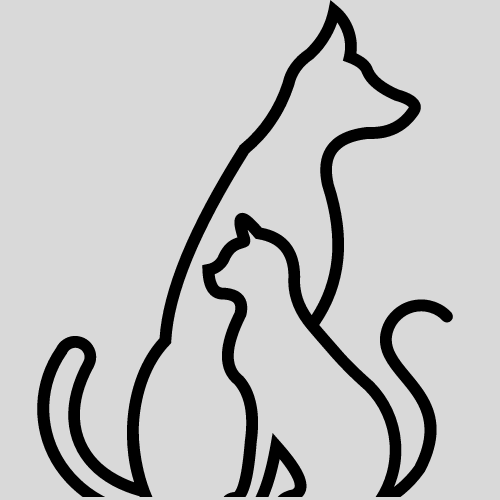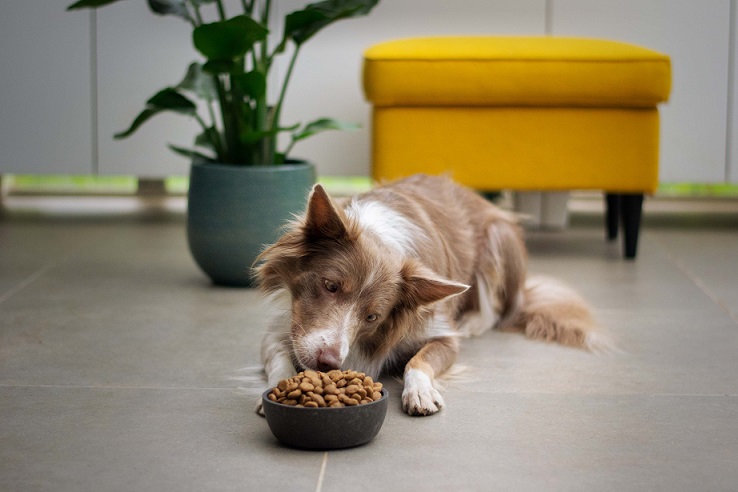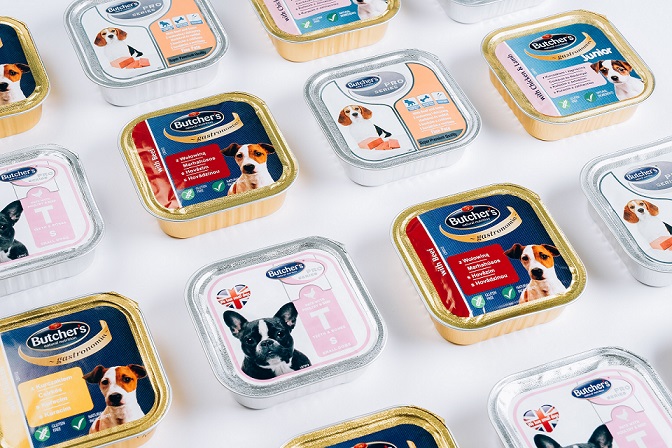When choosing a dog food or trying to figure out the best dog food for your dog, this complete guide (2022) will let you in what you need to know. This is because there are many factors to consider, but the most important is what your dog needs.
In this guide we reveal all you need to know about dog food, the types of dog foods, what dog food to feed your dog at the different stages of their life; as puppies, as adult dog or when they become a senior dog or older dog and why it is inportant to feed your dog the right food for their age and size.
This guide will be on immerse value if you a new dog owner or pet parent or you want to know what is best to feed your dog in general.
What will Make a Dog Food “Good”?
The best way to determine whether a dog food is good for your dog is to look at the ingredients. The first component that you should consider when looking for a quality dog food is the protein source.
There are several different types of proteins that can be found in pet foods, and it’s important to make sure that your dog’s diet has enough of all of them. For example, if you see cheap grains like corn or wheat as an ingredient, this could mean that there isn’t enough meat or other high-quality proteins included on the list. Corn contains gluten and wheat contains lectins – both things which dogs shouldn’t eat in large amounts!
A better choice would be meat byproducts; these include such items as feet, ears, heads and even bones (though these last two should only come from grass-fed animals). Meat byproducts contain all kinds of vitamins and minerals necessary for dogs – just make sure they aren’t
However, what makes a dog food good depends entirely on your personal preferences and on what your dog needs. The most common and accepted terms for a good dog food includes:
Complete and balanced Nutrients
This type of pet food provides all the essential nutrients for dogs to thrive. It’s also free of artificial ingredients which are added by some manufacturers. However, it is not necessarily natural or organic; these types of foods may contain some man-made additives that aren’t approved by veterinary experts. If they aren’t complete and balanced, then they don’t qualify as “good” dog foods.
Natural Ingredients
A high quality dog food should contain only natural ingredients such as meat, fish, vegetables and fruits in their raw form. It wouldn’t contain any artificial additives like corn syrup or other chemical preservatives.
It may contain man-made additives, but should not contain artificial preservatives or coloring agents. They are usually more expensive than other kinds of foods because they are made from natural ingredients, so we advice you purchase them in small quantity at first until you find out how your dog responds to them.
Freshness of the Food
The idea of a good dog being fresh was promoted by pet experts who believe a “good” dog food should not just have complete and balanced nutrients and have natural ingredents but it should also be fresh.
It doesn’t matter if this is fresh meat or vegetables; whatever it is, it should be recently harvested and not just sitting around in warehouses before reaching your local store shelf.
A number of pet experts believe there is a great difference in the health benefit between fresh dog food and a frozen one. Having fresh raw ingredients are much more vital to your dog’s health than those that have been processed with artificial preservatives and then packaged in as frozen food.
What to look for in a dog food?
I will say focus more on the quality and the source of the ingredients. Some things you would want in any dog food are ingredients that will give your pup a nutritious meal, as well as items that are good for the dog’s overall health.
There isn’t much difference between premium dog foods and budget foods so don’t let the package and the nutrition label deceive you. Some general tips to help you decide what your dog should eat can be found at [source]. However, it is best to consult with your veterinarian if you have any questions about specific food choices for your pet.
Most adult dog that are mostly indoor, are spayed or neutered usually have low energy requirements and they can live on a diet with 350-500 calories per cup. So if you have a dog food that has 500 kcal/cup and you have a dog that weighs 20 pounds the amount of food you should feed your dog should be tiny.
Where did the idea of Dog Food Come From?
Dogs were originally carnivorous, they fended for themselves and mostly survived on a carnivorous diet. After they were domesticated, people began to care for their nutritional needs by providing them with food. This practice has been documented back at least 2,000 years.
It was recommended that a dog should be fed only meat from the publication “The Sportsman’s Dictionary” for the late 18th century. A summary of book says a dog is an intelligent, powerful creature and should therefore have nutritious food. The food should not cause its body to smell bad or damage its sense of smell. It can eat fish, chicken or other poultry and can eat small portions of pork. Meat from domestic animals is of no use and should be avoided.
The dogs should eat barley, dross of wheat and barley mixed with milk or skimmed milk. If there is no time for cooking, they can eat bread or baked sheep’s legs. The dogs should not be given carrion. It hurts their sense of smell, and may cause them digestive trouble if the meat is off.
Commercial varieties of dog food
These are not necessarily nutritionally superior to those made from the best natural ingredients. In fact, most pet owners prefer the convenience of a packaged food over making their own.
About 70 percent of dog foods sold in the stores or online are produced by companies that have purchased or licensed recipes from others (Pet Food Institute, 2009). Companies can buy formulas for less and then sell them at a premium prices for about up forwards of 10x the original price. In addition to being less expensive than homemade products, store-bought dog foods also tend to be more convenient and easier to prepare.
Wet Dog Food
Wet dog food is made up of meat and water. It is often billed as a better option for dogs because it contains more nutrients than dry food. However, there are several concerns about wet dog food that should be taken into account before making a decision.
The first concern is the quality of the ingredients. Many companies that make wet dog foods use low-quality meats and other ingredients that can lead to health problems in dogs. For example, some brands contain grain fillers that can cause allergies or gastrointestinal issues in dogs.
Dry Dog Food
Dry dog food is a type of pet food that does not contain any water. It is most commonly used by dogs that live in dry climates, such as those in the desert or on mountaintops. This type of food is also good for dogs with allergies to water since they do not have to worry about moisture causing problems.
There are many different brands of dry dog food, and each typically contains different ingredients and percentages of nutrients. Some brands also sell their food with treats and toys, which can make your dog’s diet even more enjoyable.
How much dry food should a dog eat?
According to the AAFCO Dog Food Nutrient Profiles, dogs require 2-3.5 cups of dry food per day. For a small breed dog, that’s about 1/2 to 3/4 cup of dry food per meal. For larger breeds, you may need more or less depending on your dog’s size.
Dehydrated and freeze-dried
Dehydrated and freeze-dried dog foods come in various shapes and sizes, which makes it easy for any pup to find something they like. They can be bought in pet stores, online, or even at some grocery stores.
This type of food is ideal for dogs that do not like to eat wet food or who are travelling and cannot bring along enough fresh food for their pup.
Dog treats
Dog treats are a great way to reward your pet for good behavior. They are not really considered a full for a dog. Treats can be used as rewards in training, such as when you want the dog to sit or lie down. They can also serve to distract the dog from an undesirable activity, like barking incessantly at other dogs passing by outside the door.
The best part about dog treats is that they are not necessary if you have a healthy supply of regular food on hand. You can feed them once or twice a week and still get all of the benefits associated with proper nutrition for your pet.
What are Some Misinformation and Myths about Dog Food?
There are many myths and misinformation about dog food, which can lead to confusion for both humans and dogs. Some of the most common myths include:
- That all dog food must be high in protein.
- That all dog foods are created equal.
- That feeding a dog junk food will make them obese.
- All dog food is the same.
- You need to feed your dog a specific type of diet to keep them healthy.
- You need to buy expensive dog food to make sure your dog is getting the best possible nutrition.
- You need to feed your dog every day to make sure they are getting enough food.
How to Choose the Best Dog Food for Your Dog
The first thing you need to consider is the life stage of your dog. There are different types of foods available for dogs, depending on their age and health condition. For example, puppy foods have a very high amount of protein in them. This makes them suitable for puppies whose bodies have not yet grown into large adult sizes. Adult dogs can also benefit from these types of puppy foods as they help with their digestion and keep them healthy while they grow old together with you.
On the other hand, there are senior diets that contain lower amounts of protein than puppy foods do but still provide an adequate amount to help older dogs stay healthy throughout their lives by helping to maintain muscle tone as well as support joints and bones which becomes weaker over time due to aging or injury. Older dogs should be given a diet that has been formulated specifically for this situation because it will help them feel better and live happy.
What to consider when picking your dog’s food
When it comes to picking your dog’s food, there are a few things you should consider.
- First, make sure the food is high quality and made from ingredients your dog will actually eat.
- Secondly, consider what kind of nutrition your dog needs and find a food that meets those requirements.
- Finally, choose a food that’s affordable and easy to store.
What kind of diet should I feed my dog?
Generally speaking, a healthy diet for dogs should include plenty of fresh fruits and vegetables, low-fat proteins (such as chicken or fish), whole grains, and limited amounts of processed foods. Some good choices when it comes to canine food include homemade diets made from fresh ingredients or canned food supplemented with fresh vegetables and fruits.
Remember to ensure that the main components are protein, carbohydrates and fat. Carbohydrates should be as low as possible and fat should be high. Also it is suggested the optimal ratio of protein to carbs to fat should be 30-40% protein, 40-55% carbs and 15-30% fat. The best diet for pets depends on their age, breed, activity levels and health concerns.
For puppies we recommend puppy chow which has the perfect combination of high protein, low carbohydrate and complete nutrition for growing dogs.
What Type of Food Is Best for Your Dog?
It is hard to tell in this case, as the best food for a dog will vary depending on the individual dog’s weight, age, and activity level. However, a good rule of thumb is to choose a food that is high in protein and low in carbohydrates.
Some popular types of dog food that fit this description include raw meat diets, kibble diets, and wet food diets. If your pooch has already had some experience with different types of food, then choosing a good one might take some time for your dog to settle for something else.
For example, if you have an older dog who has become overweight due to a lack of exercise or poor nutrition over the years, they may not respond well to the recommended puppy diet anymore which would make switching their food difficult too.
Does Size and Age Matter for Dog Food Choice?
Yes, one size fits all doesn’t apply here! If your dog is too big for its age or if it is getting older and slowing down, then switching them over to senior dog foods might be the way to go.
It will help keep them from getting any less active as they get older because these types of food are designed for adult or senior dogs who need extra energy.
It is also good to know that large breed dogs and puppies have different nutritional requirements as compared to small breed dogs and puppies.
What Feeding Schedule Should I use?
It’s good practice to feed your dog at regular intervals throughout the day, but this isn’t necessary if your dog has special dietary needs or other medical issues.
The most common reason for a dog to have loose stools is due to a change of diet or overfeeding. Dogs can get fat on high-calorie foods, and this can cause excess gas in the stomach that leads to loose stools.
A sudden change of diet or feeding schedule, such as switching from dry kibble to canned food, may also cause your dog’s stool to lose consistency and become looser. In some cases dogs will eat more than what they need because their digestive system is too slow at absorbing nutrients from dry kibble.
How Much Food Should I Give My Dog?
It can be tough to determine how much to feed your dog, especially since there are so many different types of dog food on the market. Some experts recommend feeding your pet 1/2 to 3/4 of their body weight each day, while others suggest feeding them according to their size and activity level but not more than ten percent of what they weight per week. Ultimately, you’ll need to decide what’s best for your pet.
However, it’s generally suggessted to feed smaller dogs more frequently than larger ones. Smaller dogs require more energy due to their smaller size and high energy levels, so they typically require more food than larger dogs. Feeding them twice a day instead of once is usually recommended.
If you are feeding more than one meal per day, we recommend that you divide the total amount of food into two meals and spread these out throughout the day. It is important to watch your pet while they eat so that they do not overeat or get sick from overeating too quickly.
In addition, if you have several dogs in your household, it may be helpful to stagger their meals rather than having all dogs eat at once as this will allow them to eat at their own pace without distraction.
What’s the best way to switch my dog to a new food?
In general, the best way to make this switch is gradually over a period of several weeks or months by gradually mixing in the new food while continuing to feed the old food at least partially. There are some exceptions, such as if your dog has an intolerance to certain ingredients in their current food, then it would be best to make the switch all at once.
It’s always important to talk with your veterinarian before making any changes to your dog’s diet and always consult with a pet nutritionist if you have any questions about what is safe for your pet.
When is it right to switch my dog to senior dog food?
When your dog reaches his senior years, he will start to get a bit more fragile. This is when it is time to switch your dog to Senior Dog Food.
But first and foremost, always consult with your veterinarian before making any changes to your dog’s diet. He or she will be able to give you specific recommendations based on your pet’s health and dietary preferences.
How to Read a Dog Food Label?
The “ingredient list” is the first thing you should look at when reading a dog food label. The ingredient list will tell you what is in the product, but it may not always tell you everything. For example, if there are several grains listed as a main ingredient, then this means that those grains have been included in the product for their nutritional value and not necessarily to provide flavor.
After that you may want to check the shelf life of the product, if the date is short you may wantto avoid purchasing the product.
What to Look for on Dog Food Labels
Pet companies are required by the Food and Drug Administration (FDA) to provide pet food labels with eight key pieces of information. There are the information;
- Product name
- Net weight of the product
- The Name and the address of the manufacturer
- Guaranteed analysis
- List of ingredients
- The type animal species (i.e. dog or cat)
- Statement of nutritional adequacy
- Feeding guidelines
Please note that individual states may also have their own labeling requirements for pet products.
It is important to note that just because an ingredient appears many times on the ingredients list does not mean that it has been added in large amounts or to replace another ingredient. This can be misleading and make you think you are feeding your dog the right amount of it daily nutrient needs.
It’s best to stick with simple ingredients such as meat meal, animal fat (preferably lard), whole eggs and natural flavoring such as fruits or vegetables rather than anything else.
Signs of Low-quality Dog Food, what to avoid
- The food has a strong odor.
- The food is wet and clumps together when shaken.
- The food is discolored or has chunks that do not fall off when cut.
- The food contains pieces of bones or other hard objects.
Some Signs that show you are feeding your Dog the Wrong Food
- Your dog is not eating as much as they used to.
- Your dog is losing weight or becoming frail.
- Your dog has difficulty walking or staying on their feet for long periods of time.
- Your dog has trouble digesting food and is vomiting or having diarrhea.
Feeding your Dog for Specific Purposes
Feeding your dog with specific intention or goal in mind is a great way to know or pick what dog food to buy for your dog.
Here are a few reasons to pick a food for your dog based of specific needs, some for health reasons. others based on the size and age of the dog. You want to look out for nutrients and other ingredients based of what your dog needs at the time.
Dog food for dental issues
Dental issues are common in dogs, and can be caused by a variety of factors. One of these factors is the type of food that a dog is eating. Certain nutritionally-rich foods can help to improve dental health in dogs, and may also help to prevent other health problems. Some of the most common food nutrients that can help with dental health in dogs include omega-3 fatty acids, calcium, and vitamin D. We wrote a guide on choosing the best dog food that will help if your dog has dental issues.
Dog food for less poop
There is no one answer to this question as different dog breeds require different levels of nutrients to maintain their health. However, some common nutrients that can help a dog poop less include calcium, magnesium, and phosphorus. These minerals help keep the digestive system working properly and can also help regulate bowel movements.
Dog food for sensitive stomachs
One of the most common reasons dogs develop sensitive stomachs is because they are not getting the right nutrition. When a dog doesn’t get enough nutrients, their body can’t function properly and they can develop sensitive stomachs.
One of the key nutrients that helps to support a dog’s sensitive stomach is fiber. Fiber helps to bulk up the stools and keep them from becoming too loose which can help to ease digestive problems in dogs.
Dog food for heart disease
There is a growing body of research that suggests that certain types of dog food may help to improve the health of dogs with heart disease. One such nutrient is omega-3 fatty acids. Omega-3 fatty acids are important for the health of both dogs and humans, and studies suggest that they can help to reduce the risk of heart disease in both species. In addition, other nutrients found in high levels in some dog foods, like fiber, may also be beneficial for heart health. However, it is important to make sure that your dog’s diet includes a variety of nutrients to ensure optimal health.
Dog food for joint health
Many dog owners are familiar with the common names for the main ingredients in dog food, but may not be aware of all of the nutrients that are included. One important nutrient that is often lacking in dog food is joint health. While there are many different types of dog food available on the market, most contain a limited number of joint-friendly ingredients. One nutrient that can help support joint health in dogs is glucosamine. Glucosamine is a natural compound found in both human and animal joints, and has been shown to improve joint function by promoting cartilage production. Additionally, glucosamine can help to reduce inflammation and pain in dogs with arthritis or other forms of joint disease.
Dog food for easy digestion
A dog’s diet is very important for their overall health and well-being. A healthy diet helps a dog easily digest their food, which in turn helps provide them with the nutrients they need to stay healthy. One of the most important nutrients for a dog to consume is digestible protein.
Digestible protein helps a dog break down their food and absorb all of the necessary nutrients. Not all dog foods contain enough digestible protein, which can lead to problems like poor dental health and malnutrition. To help ensure that your dog gets the most out of their diet, make sure to choose a food that has plenty of digestible protein.
Dog food for allergies
Allergies are a common problem for dogs and can be quite frustrating. If your dog is allergic to something in their food, you may be wondering what you can do to help them. There are many different types of allergens and not all of them are found in every type of food. However, some common allergens that dogs are allergic to include wheat, corn, soy, dairy, chicken and beef.
One common allergy-fighting nutrient that is found in many dog foods is gluten. Gluten is a type of protein found in many grains including wheat, barley and rye. Many people with celiac disease also have an allergy to gluten which is why it’s important for these pets to have gluten-free diets.
Dog food for pancreatitis
There are a few different types of nutrients that can help a dog with pancreatitis. Some of these nutrients include B vitamins, magnesium, and omega-3 fatty acids. It is important to talk to your veterinarian about the best food for your dog with pancreatitis, as each individual may require a different type of nutrient.
Dog food for weight gain
Many people believe that feeding their dog a high-quality diet is the key to ensuring their pet stays healthy and fit. However, not all dog food is created equal- some contain more nutrients than others, which can help a dog to gain weight. In fact, one of the most important nutrients for dogs to consume is protein.
Protein helps dogs to build muscle and maintain their weight, so if your pup is looking for a way to put on some pounds, providing them with a high-protein diet is one of the best ways to do it. Some of the best sources of protein for dogs include meat, poultry, fish and eggs. Be sure to read the ingredients list carefully before you buy your pup’s food though,
Dog food to stop dog from shedding
There are many dog food nutrients that can help to stop a dog from shedding. One of the most common is called glucosamine. Glucosamine helps to keep the connective tissue in a dog’s skin healthy and strong, which can help to reduce shedding.
Dog food for weight loss
There are many dog food nutrients that can help a dog with weight loss, but one of the most common is fiber. Fiber helps regulate blood sugar levels and can help keep a dog feeling full after eating. Other nutrients that can help with weight loss in dogs include protein, vitamins B and C, and minerals like magnesium and potassium.
Dog food for puppies
There is no one perfect food for all puppies, as their individual needs will vary. However, there are some general guidelines that can help you choose the right food for your pup. When selecting a puppy food, it is important to consider the size and age of your dog, as well as his daily activity level. The following are some general tips to help you choose the right diet for your pup:
- Be sure to feed a high-quality diet that meets the nutritional needs of your pup. Puppy foods should contain adequate amounts of protein, fat, and carbohydrates to provide energy and sustenance.
- Choose a puppy food that is formulated specifically for puppies; this will ensure he gets all the nutrients he needs
Dog food for small dogs
There are many dog foods on the market that are specifically designed for small dogs. These foods typically have a lower calorie count and a lower amount of protein, which makes them more appropriate for smaller breeds. Some small dog owners choose to feed their dogs a diet that is made up of mostly kibble, because it is easy to digest and provides all the nutrients their dog needs.
Dog food for large dogs
Large dog breeds require a higher-quality diet than smaller dogs. This is because large breeds tend to have bigger bodies and more muscle mass, which requires more calories and nutrients to support.
One of the most important factors in choosing a high-quality dog food is the type of protein it contains. Large dog breeds need a high-quality protein source that is both complete and balanced, including essential amino acids and vitamins. Some of the best options for large dog foods include raw meat diets, lamb and beef based diets, or premium kibble brands that specifically target large breed dogs.
Dog food for senior dogs
As dogs age, their nutritional needs change. This is especially true for senior dogs, who may have less muscle and bone mass and may be more prone to chronic health problems. A diet that is high in protein and low in carbohydrates is essential for senior dogs.
Many dog foods marketed as being specifically for senior dogs are actually low in protein and high in carbohydrate content. These types of diets can lead to weight gain, poor health, and even death in older dogs. To provide your senior dog with the best possible nutrition, choose a food that is high in protein and low in carbohydrates.
How do I know my dog needs Senior Dog Food?
If you notice that your dog has started losing weight or stops eating as much as usual, then this may be a sign of getting older and maybe even developing some health problems. Look for these signs:
- A decrease in activity.
- An increase in sleeping time.
- Losing hair or shedding.
These signs may also be accompanied by other symptoms such as:
- Difficulty getting up from a lying position (known as ‘crawling’).
- Trouble walking on all four legs.
- Loss of appetite.
If you think your dog is showing any of these signs then it’s important that you take then to see the vet right away so they can have tests done to rule out any health issues.
what is Grain-free dog food?
Most dogs, including those with food allergies, are very sensitive to grain and it is a common ingredient in dog food. However, the majority of grain-free dog foods contain small amounts of grains or meat byproducts (such as corn or peas) that can cause allergic reactions in some dogs. For example, while one brand may claim to be grain free and hypoallergenic, they still have wheat in their product which could cause an allergic reaction for some. Grain-free dog foods are typically high protein diets that do not contain any grains at all (like soy). These types of diets tend to be more expensive than regular commercial products but provide your pup with everything he needs without the risk of causing an allergy.
Is grain-free dog food better?
A grain-free diet is thought to be healthier for dogs. It removes the wheat, corn and soy from dog food, which are often used as cheap fillers. It may also contain more meat or fish than a regular dog food, but it is still possible that grains can cause health problems, even if they aren’t in the actual ingredients.
Grain-free diets also tend to have fewer calories and fat than other brands of dog food. The main ingredient in most grain-free foods is usually chicken or turkey meal (also known as poultry byproduct), which contains less protein and fat than some meats such as beef or lamb. Because these types of meals are relatively low in protein content (about 25%), it’s likely that your dog will need to eat more of them per day to meet his daily requirements for nutrients like calcium, phosphorus and vitamin A.
Do vets recommend grain-free dog food?
Some veterinary nutritionists may recommend grain-free dog food when they see a dog with allergies. In fact, the American Animal Hospital Association (AAHA) has recommended it for many years as an essential part of a healthy diet for dogs.
What is human-grade dog food?
Human-grade dog food means that the ingredients used to make it meet certain minimum standards of quality. Human-grade dog food is not necessarily “good” or “better” than other foods. A good rule of thumb is that human-grade foods are made from at least 95% human-quality ingredients, and use no artificial preservatives, colors or flavors.
“While I don’t have a strong preference to any one type or brand of diet, I can say that the human-grade foods that I had experience with are highly palatable and digestible. The result was a low volume of stool that allowed for easy clean up.”
Why is it important to buy human-grade dog food?
Most of the time, dog food is made from animal products. This means that it may contain small amounts of meat byproducts, which is a problem for some dogs. By purchasing human-grade dog food you are ensuring that your pet will receive the best nutrition possible while avoiding any potential health issues caused by switching to a new type of diet. The truth is, most commercial dog foods are loaded with artificial chemicals and preservatives so if you want to feed your pup something that isn’t going to harm their body in any way then human-grade dog food is the way to go!
How do I know what human grade dog food brands are good?
There are websites out there that list all kinds of information about different types of pet products but many simply list them as being “human grade” or “natural” which can be misleading at times since they don’t really specify what this actually means.
If you would like to know more about human-grade dog food then I would recommend searching for information on the following websites:
The Honest Kitchen:
A human-grade dog food made from real ingredients. The Honest Kitchen is also one of my favorites because it uses an ingredient called apple cider vinegar which is a natural way to keep your pet’s coat healthy without using any chemicals or synthetic preservatives.
Tiki Cat Treats:
These treats are not only organic but they are also human grade and non-GMO, so you can rest assured that your kitty will be receiving a quality product! And yes, they look delicious too!
Natural Dog Foods:
This is another great website that provides detailed information about human grade dog foods. They even have their own top 10 list of recommended brands!
Dog Food Advisor:
One thing I really like about this website is that it has ratings and reviews by other pet owners who have tried out different types of dog foods. It’s always good to know what others think about the different food and brands.
What is a raw food diet?
A raw diet is one that’s entirely or mostly natural and unprocessed. The idea behind a raw diet is to provide your dog with the healthiest foods available at the time, while still keeping them very much in touch with their natural instincts.
What are some of the benefits of feeding my dog a raw diet?
The main benefit of feeding your dog a raw food diet is that it allows you to control exactly what goes into their body. You can add vitamins and minerals as well as different types of fat, such as coconut oil and rapeseed oil for example, which may be beneficial for dogs who suffer from specific health issues like arthritis or joint pain.
Other than that though, there doesn’t seem to be any other major advantages over dry kibble (or canned). It’s also worth noting that many people do feed their dogs whole grains instead of kibble so if you want to try this out yourself then feel free!
Is a raw food diet good for my dog?
Yes! Raw diets are one of the best ways to keep your dog healthy and happy. They are a natural way for dogs to eat and contain all the essential nutrients that they need, including vitamins, minerals and protein.
The main ingredients in raw diets include fresh meat (preferably organically fed), fresh vegetables, fruits, seeds and nuts. These foods can be ground into a dry or semi-moist food to make it easier for your dog to eat. Your dog will love them!
Can I feed my dog raw meat?
Yes, you can feed your dog raw meat or other fresh meats or organs. You should not feed your pet raw bones (or any bones that are not designed for humans), because canine teeth are different from human ones and cannot handle them safely. Be sure to ask your veterinarian about feeding raw meat to your pup!
Is dog food with low fat good?
There is a lot of debate about whether or not low fat dog food is good for dogs. Some people believe that it is healthier for them to eat low fat dog food, while others argue that it isn’t as healthy as regular dog food. Ultimately, what you choose to feed your dog is up to you and what you believe is best for them.
There are many dog food nutrients that can help to stop a dog from shedding. One of the most common is called glucosamine. Glucosamine helps to keep the connective tissue in a dog’s skin healthy and strong, which can help to reduce shedding.
Is dog food with probiotics good?
There is a lot of debate about whether or not dog food with probiotics is good for your pet. Some people believe that it is beneficial, while others are skeptical. The jury is still out on this one, but if you’re interested in trying it out, be sure to talk to your vet first.
Is dog food with fish oil good?
This is a great way to get your dog the omega-3 fatty acids they need. But it’s easy to overdo it on fish oil, especially if you’re using cod liver oil capsules instead of fish oil supplements.
Cod liver oil has more vitamin A and D than salmon, but not nearly as much as fish oil. It also contains significant amounts of vitamin E, which may have benefits for dogs with joint problems. However, most studies suggest that the amount of vitamin E in cod liver oil is too low to be effective for promoting heart health or preventing cancer in dogs.
The bottom line: If you want your dog to see better or feel better (or both), then try giving him some fish oil supplements along with his regular dog food diet!
What to Look for in a Dog Food Brand
If you are a dog owner, then you will probably already be aware that there are many different types of dog food brands available on the market. While most of these foods come from reputable companies, some can also be less than desirable and may not contain the nutrients your pet needs.
There is so much information out there about dog nutrition, but it can sometimes feel overwhelming for new owners to decide which brand to buy. If you want help in making this task easier for yourself, then we have put together our top tips for deciding on a good quality dog food brand.
One thing to note though is the best dog food brands have been around for a long time and have consistently improved their products to provide the best quality of food. When you’re looking for the best dog food brands, it’s important that you look at what they are known for; ingredients, taste and nutrition.
As with any other product or service, there are always going to be some negative reviews but if you stick with a trusted brand like Pedigree, then you can rest assured knowing that your dog is getting the best possible quality of food.
What type of diet?
There are two main types of diets – dry and wet foods. The main difference between them is how they are made; dry foods use grain-based ingredients while wet foods use meat or vegetable ingredients (such as chicken) mixed with water. As well as this, wet food usually contains added vitamins and minerals to make up for what is lacking in the ingredient list compared to dry food.
So, if you’re looking for a complete food that will help your pet maintain good health and provide them with all the essential nutrients they need to live a healthy life, then wet food is definitely for you!
Final words
Taking care of your dog is a rewarding experience that requires some effort, but it’s worth it. By following these tips, you can ensure your dog lives a long and healthy life.
One important thing to remember is that dogs need a balanced diet. A good rule of thumb is to feed your dog about one third of its body weight in pounds each day. This means that a small dog should be fed about 1/3 of a pound each day, while a large dog should be fed about 2/3 of a pound each day. Additionally, make sure that all of the food you give your dog contains only a small amount of meat. You can use canned or raw meat in your dog’s meals to make sure that they get all the nutrients they need.
If you have been trying to find out how to give your dog the best diet possible then you should now be able to do so with ease. There are many different ways that you can feed your dog a healthy and nutritious diet and there is no one way that will work for every single type of canine. However, following these tips should help ensure that your pet is getting everything it needs from its food, making it healthier and happier than ever before!
Finally, be sure to keep your dog exercised and mentally stimulated. This will help to keep it healthy and happy.









